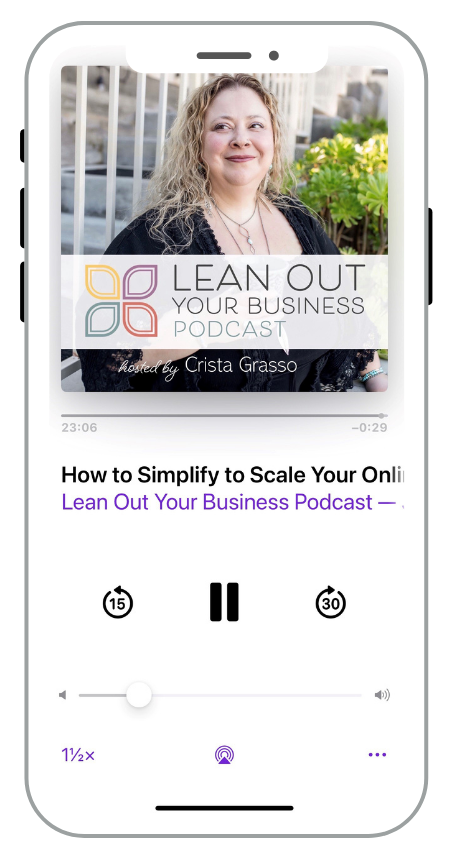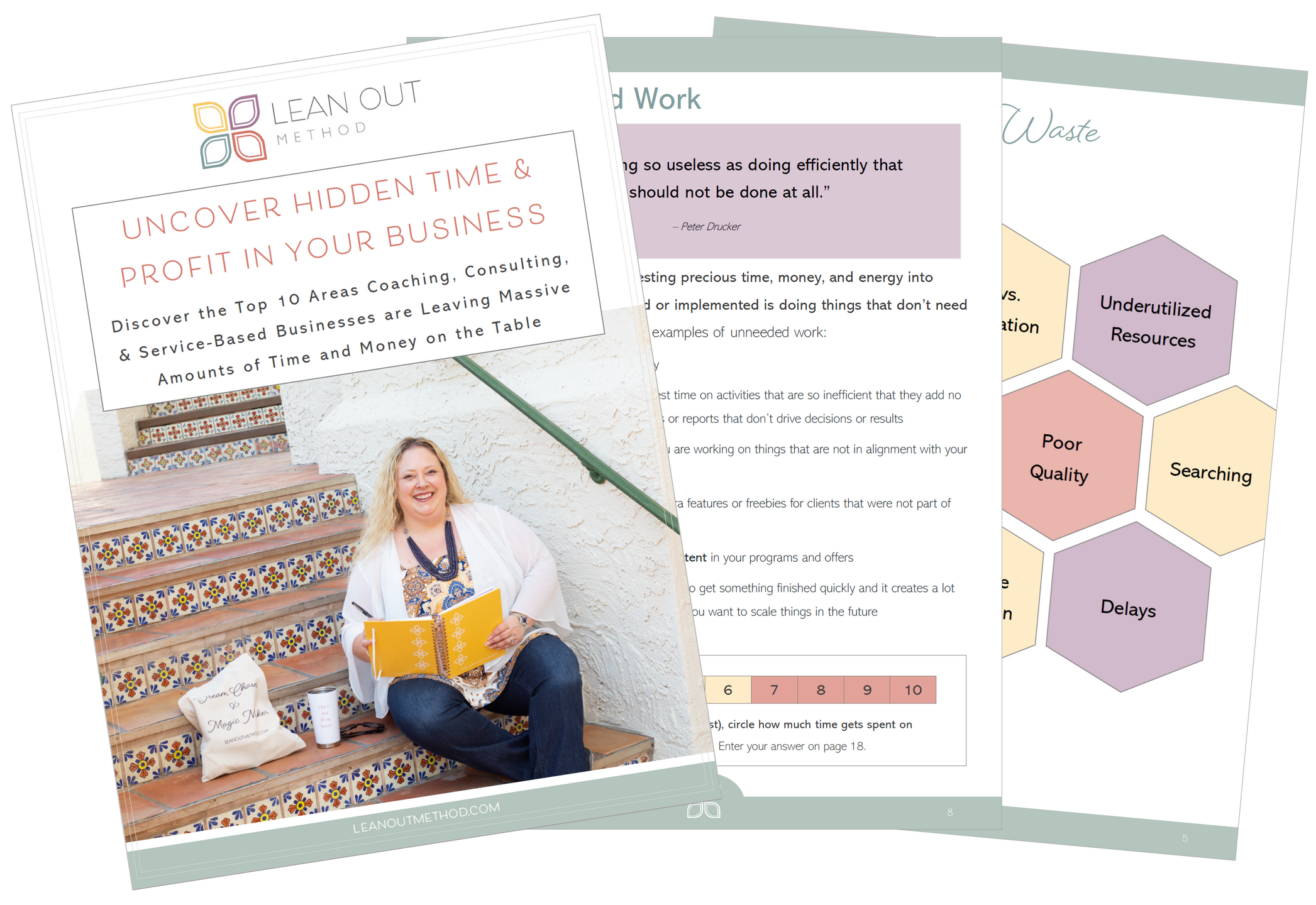E23 How to Build Long-Term Financial Success in Business with Kathy Svetina
Explore Other Episodes
When you are growing and then scaling your business, finances play a big role in the speed and sustainability of your success. Having a solid financial plan, understanding the difference between revenue, profit, and cash flow, and strategically planning launches with your finances in mind is how to balance short-term wins with sustainable long-term growth.
We dive into each of these topics inside Episode 23 of The Lean Out Your Business Podcast, where I interview Kathy Svetina, Founder of New Castle Finance, a company that offers fractional CFO services for women-owned businesses.
In this episode, we dive into:
- Creating a budget and financial plan for your business
- The important difference between profit, revenue and cash flow
- Having a profitable launch
- The three stages of a launch to plan for
- Deciding the best KPIs (key performance indicators) for your business
The Key to Creating a Healthy and Financially Sustainable Business
If you’re ready to get clear on your financial strategy the very first thing you need to do is get strong, accurate, financial data around your business. In Kathy’s words, “you can’t make strong decisions if you don’t have accurate data.” The foundational piece of your business is having good data.
Data and analytics may not be something you love to focus on in your business, but it is really important. Most of us didn’t start our businesses because we love data and when something isn't our passion, it can be really easy to prioritize other things (delivering our products/services, marketing, growing our team, etc). Maybe recording and analyzing your financial data intimidates you, maybe you’re so busy delivering on client fulfillment that you think, “I’ll get to it later.”
The problem with “later” is that by the time we actually get our records up to date; it’s often too late.
So what if data is just simply not your thing? You have two options:
- Recognize the importance of it and commit to keeping accurate and current books
- Hire someone as soon as possible to manage this piece for you
If you immediately dismiss the idea of hiring a bookkeeper and accountant, really think through how that financial decision is going to affect you in the long-term, in a year, in two years. Not hiring someone to help you might save you money and time investment in finding them in the short-term, but how does it affect the long-term growth and sustainability of your company?
The Importance of Financial Planning
Now that you have a strong financial foundation (you know how much money you have in the bank, you know your expenses, you know your profit), you can start to analyze that data and make strong financial decisions for the future.
It’s time to plan and by plan I don’t mean create a budget and then file it away and allow it to collect dust in the back corner of your office.
No, this is a living document, a friend you check in with, see how she’s doing on a regular basis. You’re going to look at it a minimum of once a month to:
- See if you are on/off the budget you set
- Decide how you need to adjust based on new activities within the business (did you get a new customer, have existing customers started paying more slowly)
- Decide how to spend your money/resources based on current data
This is called forecasting. And once you’ve forecasted you can start strategic planning. Where do you want to be in 3, 5 of even 10 years? What is your ultimate goal? Do you want to sell, do you want to grow a multi-million-dollar company, do you want to open an IPO?
Having a strategic plan, is a key way to avoid shiny penny syndrome. Having a clear focus/goal will act as a beacon for your company, and as long as you stay on track, you’ll ultimately make more profit. And isn’t that the entire point? You need to make a profit in order to do what you want, in order to have the impact you want, to grow/scale in the way you want.
Profit matters.
Understanding Profit vs. Revenue
Profit is the amount of money that you get to keep, after you pay for all of the expenses associated with the sale. For instance, Kathy uses the example of selling a $5,000 course.
The sales/revenue is $5,000. That’s where you start. But now you have to:
- Actually, invoice and get paid for that sale, taking into consideration whether or not you get paid up front, in stages or once the work is complete/the item is delivered. All of these things will affect your cash flow.
- Account for expenses. Do you have employees you need to pay immediately (not when the payment comes in), were there marketing expenses (i.e. Facebook Ads) attached to the sale and let’s not forget that we automatically need to set aside the taxes from the sale.
Once you account for all of the expenses associated with the sale you might actually profit $2,000, from the initial $5,000 revenue.
Planning a Launch
If you’re getting ready to launch an online course/program/business, I want you to pay close attention to what I’m about to say, don’t get distracted by the flashy advertisements. You know the ones, where Joe so and so claims he had a 6-figure launch and Sally so and so claims she had a 7-figure launch. That may be true, in revenue, most likely it’s not true in profit.
This is a really important time to keep your eyes on your own paper and not to base your internal business decisions based on someone else’s external marketing.
I’ve been behind the scenes, watching many of these programs launch, and while externally they are announcing 7-figure launches, internally they are worried about how they are going to make payroll.
As you launch your program be obsessed with profit, not revenue and stay focused on your strategic growth strategy.
A successful launch is only successful if you have the people and strategies in place to support your new client base.
If you bring in $20,000 in revenue, how much of that will you keep and how much will go out (either in resources or new hires) to support that new client base? Do the upfront work to make sure your profit is worth the effort you are going to put into it.
Systems and KPIs
I love strategic systems because they allow you to simplify your business and this is very true when it comes to the three stages of your launch:
- Pre-launch
- Launch
- Post-launch
In each stage you may need different systems in place to achieve success and in the same way you may also need different KPIs, because what’s important in one stage might not be as important in another stage.
If you’re wondering what KPIs are, they are the key performance indicators in your business. Think of it this way, if you’re on a deserted island and need to call the office to check in, what are 3 to 5 things you need to know to determine the overall health of your business and what needs to happen next.
There are two really important things to remember when it comes to creating KPIs:
- You do not want to have too many. The idea is that these are THE most important things in your business. If they are THE most important, then there can only be a few. Stick to 3 or 5 max and don’t allow yourself to get overwhelmed with more.
- You need to create KPIs that are important to YOU, not just what popped up when you Googled “examples of KPIs.”
If this is your first time creating KPIs and you aren’t sure where to begin, start by answering these three questions:
- What is my end goal?
- How do I track the success on my path to my end goal?
- How do I know that I’m successful?
For the Lean Out Method I have three main KPIs, and although they aren’t necessarily financial KPIs, they directly impact the finances of my business. They are:
- The number of power partner calls I make – referrals are a big part of my business growth strategy. The more calls I make the more growth I see.
- The number of sales/discovery calls booked
- The number of signups for my events/courses/webinars
In Summary
If you want to build long-term sustainable success you need to a have a strategic plan for your business and the foundation for this plan is your finances. In order to have your arms around your finances you are going to:
- Create a budget for your business (taking into account all incoming and outgoing funds)
- Check in with your budget on a monthly basis, adjusting for any new opportunities or obstacles that have come up since your last check in.
- Carefully plan your next launch, understanding how much profit you will make and the infrastructure that you will have to have in place to sustain the growth from a successful launch
- Set KPIs for your business and check in on them regularly
Connect with Kathy:
ABOUT THE SHOW
The Lean Out Your Business Podcast is a show dedicated to helping entrepreneurs accelerate business growth and simplify success.
Hosted by Crista Grasso who has been helping businesses for more than 2 decades to lean out by optimizing what's working and eliminating anything not adding value.
If you are ready for more time back in your day and more profit in your business, while doing business differently and growing and scaling on YOUR terms, tune in to the podcast.

SUBSCRIBE ON YOUR FAVORITE PLATFORM

UNCOVER HIDDEN TIME AND PROFIT IN YOUR BUSINESS
Download our proprietary waste guide to uncover where you could be getting time back in your week and increasing your profit margin
If you have ever found yourself wishing there were more hours in the day or more profit in your business, the reality is that there is hidden time and money in your business.
After spending more than 20 years working with businesses to uncover hidden time and profit as they scale, I've identified 10 of the top areas coaching, consulting, and service-based businesses leave massive amounts of time and money on the table. Download the free guide to determine where you have hidden time and money in your business.


